Soil Fertility Guide
Nitrogen (N)
Plants use both the ammonium (NH 4 +) and the nitrate (NO 3 -) forms of nitrogen (N) in the soil - but primarily the nitrate form. Nitrate-nitrogen (NO 3 -N) levels vary considerably from field to field and year to year because of differences in soil types, climatic conditions and management practices.
| Stubble fields generally contain inadequate N levels for optimum crop production. Residual nitrate tends to be higher in fields following the more heavily fertilized row crops, such as potatoes and corn, than the solid-seeded cereal and oilseed crops 2 (Table 2). Fields that have been heavily manured, repeatedly fertilized with high rates of N and/or affected by drought, or some other factor that has severely restricted yields, often contain higher than average residual nitrate levels. Extremely high N levels were encountered in the fall of 1988 and 1989 following droughts throughout a large part of the province. Sometimes fallow fields contain enough available N for crop production. Fields where a green manure crop was "worked in", or fields in which a crop was "ploughed-down" because of drought, severe insect damage or hail, usually contain higher nitrate levels than stubble fields, but lower than fallow. |
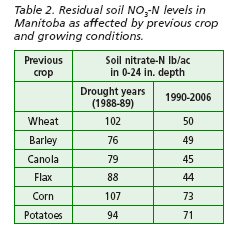 |
Following legume breaking (breaking after first cut of forage), soils will release considerable quantities of N, which may satisfy all the N requirements of the crop. Grass and grass-legume breaking provide a lower, but substantial level of N for following crops. The amount of N available is determined by the time of legume forage crop termination and density of the legume stand (Tables 3 and 4) 3 . Manitoba research indicates that either tillage or herbicide termination of the stand are equal in releasing N for subsequent crops.
This N contribution is based on a full stand of alfalfa. The N contributions should be adjusted for lesser alfalfa stands accordingly to Table 4.
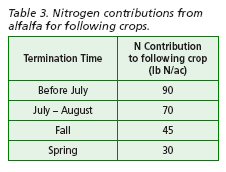 |
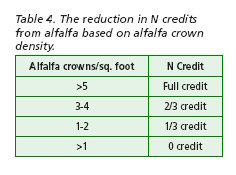 |
Pulse Crop Nitrogen Contributions
It is recognized that N requirements for crops may be reduced following pulse crops. Traditionally N recommendations were not reduced for crops following pulse crops in Manitoba since the greater yield potential that frequently occurs following pulse crops required similar N rates as when crops follow cereals 4 . In addition to the higher yield potential, wheat often has higher protein concentration following pulse crops.
Recent research has evaluated N contributions from field peas, soybeans, chickpea and dry beans harvested for grain 5 . Apparent N credits are small (10 lb N/ac or less) for soybeans and dry beans. Field peas provided the most consistent N benefit of some 25 lb N/ac. Field peas are traditionally harvested in early fall and under moist conditions, mineralization and N release are detected by the late fall nitrate soil test.
Summerfallowing has a detrimental effect on soil quality and leaves the soil susceptible to erosion. Therefore, except for certain emergency situations, summerfallowing is NOT a recommended practice in Manitoba. Any tillage should leave sufficient stubble cover to prevent soil erosion. Poorly maintained summer fallow or fields that have been broken or ploughed down late in the season usually contain available N comparable to, or lower than stubble fields.
Nitrogen contributions are greater when forage or grain legume crops are grown as a green manure crop. Under such production the crop is destroyed at vegetative stage and nitrogen returned to the soil. For legume or pulse crops, every 1000 lb of vegetative material contains some 30 lb of nitrogen. Half of this plant nitrogen is available to the following crop, with some 15% being available in year 2. Typical amounts of nitrogen produced in Manitoba studies are shown in Table 5.

Fertilization of Annual Crops
Effects of nitrogen and moisture supply on crop yield and quality
Most non-legume crops respond well to fertilizer N when the available soil levels are low. N fertilizer is effective in increasing both yield and protein content of crops on deficient soils. On soils low in available N, applications of moderate rates of N usually result in yield increases. When soil levels are high or high rates of N are applied, both yield and protein content are increased, as well as the risk of lodging.
Growing season moisture conditions also have a significant effect on crop response to available soil N and applied fertilizer N (Figure 1).
Generally, higher moisture availability results in higher yields at comparable N supply levels, as well as a greater response to applied fertilizer N. Lower moisture availability not only restricts response and yield potential, but also results in higher crop protein contents, particularly at higher levels of available N.
High protein Canadian western red spring wheat can be grown in all areas of Manitoba if sufficient N is available to the crop from the soil and/or applied fertilizer. To determine if sufficient N was present for high yield, the grain protein content can be checked. If spring wheat protein content is less than 13.5% 8 (11.5% for winter wheat 9, 10 ), insufficient N was added to optimize crop yield.
For a recommended malting barley to be acceptable for malting grade, the grain should contain 10.5 to 13% protein. Protein levels in barley are determined by the amount of available N, seeding date, growing season moisture and temperature. Late seeding, high rates of N and/or limited growing season moisture may result in protein content above acceptable levels.
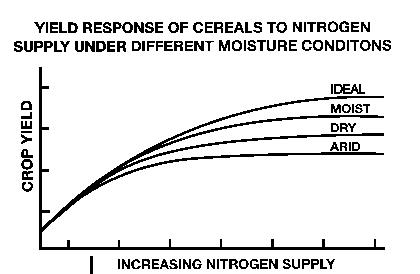
Figure 1
Very high levels of available N may have a negative impact on growth and, in some crops, quality. A heavy, lush crop resulting from high N levels may be prone to lodging and more susceptible to disease under certain climatic conditions. Seed set may also be reduced and maturity may be delayed. In oilseed crops, oil content tends to decrease as protein content increases in response to high N and/or low moisture conditions.
Nitrogen Fertilizer Efficiency
Fertilizer N efficiency is significantly influenced by certain soil properties, climatic conditions and the time and method of placement. The efficiency gained in N management is primarily through reducing N losses from the following processes:
Denitrification occurs under flooded or saturated soil conditions when soil bacteria convert nitrate-nitrogen to nitrogen gas (N 2O and N 2). It is the most common way that N is lost and occurs slowly at soil temperatures slightly above freezing, becoming very rapid at temperatures above 15°C. Losses in spring flooded soils may be 2-4 lb N/ac/day. Losses in poorly drained fields between June and October can result in the loss of much of the available N in several days. Denitrification can be greatly limited by providing good field drainage and using fertilizer management practices that retain N in the ammonium form (e.g. subsurface banding).
Immobilization refers to the temporary loss of N as soil organisms work to decompose crop residues that have a low concentration of N (e.g. cereal straw). Nitrogen becomes available again when the organisms die and decompose. Immobilization can be limited by subsurface banding N fertilizer, which makes N more available to the crop and less available to soil organisms.
The C:N ratio of crop residue plays an important role driving the rate at which nitrogen is cycled by soil micro-organisms (Table 6) 11 . If the C:N ratio is less than 20:1 then mineralization or the release of nitrogen occurs. If the C:N ratio is greater than 20:1 then immobilization or nitrogen is tied up within the field. The C:N ratio of crop residue declines as the residue decomposes (i.e. C is released as CO2). Nitrogen is temporarily tied up in residues having high C:N ratios (e.g. wheat straw or corn residue) however, as the C:N ratio declines to 20:1 mineralization (N release) can occur. The magnitude of immobilization is directly related to the quantity of crop residue. High residue crops such as grain corn or cereals immobilize more N than low residue crops such as dry beans (Table 8).
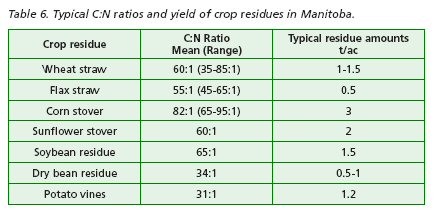
Nitrate leaching is the downward movement of the nitrate form of N by water moving through the soil profile. Nitrates are water-soluble and move readily since they are not held by soil particles. Nitrate leaching occurs most readily on coarse textured soils following significant precipitation. Nitrate leaching can be minimized by applying only enough N fertilizer to meet crop needs, applying fertilizer as close as possible to the time of crop uptake and using moisture efficiently. Nitrate leaching during the growing season is highly unlikely even in very sandy soils under dryland conditions. Irrigation of sandy soils can often lead to leaching even during the growing season unless special management is practiced (i.e. split applications of nitrogen or via irrigation water).
Ammonia volatilization occurs when the ammonium-N from broadcast urea, urea-ammonium nitrate solutions (UAN) or manure converts into ammonia gas and dissipates into the atmosphere. Factors that increase volatilization losses are higher temperatures, a moist soil followed by drying conditions, high soil pH and high levels of free lime or calcium carbonate. Ammonia volatilization can be limited by subsurface banding N fertilizers (especially urea) into the soil or incorporating broadcast applications. The urease inhibitor, Agrotain, will delay volatilization from urea and UAN solutions for up to 14 days. Refer to manufacturer's directions for more information.
Methods of nitrogen fertilizer placement
Banding
There are several types of band applications:
- drilled with the seed
- side banded
- mid-row banded
- sub-surface banded into soil prior to seeding
- surface banded
- nested
Drilled with the seed This method consists of placing the fertilizer with the seed in the seed row. Drilling fertilizer with seed in excess of recommended rates can cause seedling damage and reduce yields. Depending upon the equipment used, there can be a large variation in the concentration of fertilizer adjacent to the seed. Greater spreading of the fertilizer and seed and lower rates of fertilizer, reduce the likelihood of seedling damage. A double disc press drill places the seed and fertilizer close together in a narrow furrow. A discer, air seeder or hoe drill can scatter the seed and fertilizer, depending on the opener used. Wider spacings between rows increases the concentration of fertilizer in each seed row.
Placing fertilizer with cereal seed optimizes efficiency. However excessive rates of nitrogen fertilizer may lead to reduced germination and seedling damage due to ammonia toxicity or salt burn. Table 7 12 contains guidelines for safe rates of N placed with the seed of cereals and canola. For more details refer to the Manitoba Agriculture, Food and Rural Initiatives (MAFRI) fact sheet, Guidelines for Safely Applying Fertilizer with Seed . Factors affecting safe N rates include crop type, row spacing, seed and fertilizer spread, soil texture, N source and soil moisture.
For canola, ammonium nitrate and ammonium sulphate are just as damaging to the seedlings as urea. For cereals only, suggested N rates can be safely increased by about 20 lb N/ac when ammonium nitrate is used. UAN solution is 50% urea and 50% ammonium nitrate, so would be intermediate in toxicity between the two granular products. The urease inhibitor, Agrotain reduces seed toxicity from seed-placed urea 13 . Suggested N rates for cereals and canola may be safely increased by 40-50% when urea is treated with Agrotain. Refer to manufacturer's instructions for specific information.
Where seedbed moisture is low or when weather is hot and windy, reduce the rates in Table 7 by approximately 50 per cent.
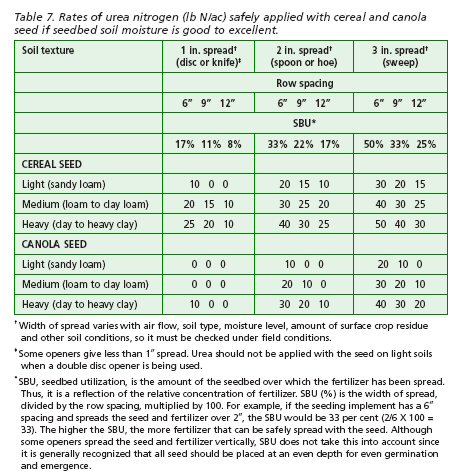
Side band placement - This method consists of placing the fertilizer in a narrow band 2 to 3" to the side and/or 2 to 3" below the seed during seeding. The efficiency of side banding is equivalent to placement with seed and higher rates can be used safely.
Nitrogen requirements of most crops can be met without causing seedling damage when solution or dry fertilizer is placed at least 2" from the seed row.
Anhydrous ammonia cannot be placed in or near the seedrow.
However, equipment has been modified to allow anhydrous ammonia to be applied at seeding time in a band or other arrangement that is separated from the seed. The anhydrous ammonia should be separated from the seed by at least 2-3" and placed below and to the side of the seed or to the side of the seed. It should not be applied directly below or above the seed. The anhydrous ammonia tends to follow the furrow upward, so attempts at placing it below the seed will likely lead to seed damage.
Mid-row banding - This method places fertilizer between every second seed row as part of the seeding operation. The fertilizer is banded with knives, discs or coulters to a depth of 3 to 4". This system is an efficient method of N placement, which allows the application of high rates without risk of damage to germinating seedlings.
Banding into soil prior to seeding - This method places the fertilizer below the soil surface in a band behind a shank at a depth of 3 to 6" It is often referred to as "deep banding".
Band spacings should not exceed 18" when applying nitrogen fertilizer. The efficiency of this method of N placement in spring is equal to side banding or seed placing fertilizer.
Anhydrous ammonia should be applied only when soil conditions permit a good seal behind the applicator shanks. Seeding can be done immediately after anhydrous ammonia application, provided there is at least a 4" vertical separation of the injection point and the seed 14 . Crop emergence may be slightly reduced directly over the anhydrous bands, particularly for small seeded crops and if soils are sandy or dry. However, plants will tiller or branch and yield will not be affected. The ammonia bands should be perpendicular to the direction of seeding.
Surface banding - This application method places a band or stream of liquid fertilizer on the soil surface. The equipment used include fertilizer floaters and field sprayers outfitted with dribble nozzles or streamer bars. Surface banding improves nitrogen efficiency as compared with broadcast methods because volatilization and contact with residues and possible immobilization, are reduced. The liquid stream also penetrates a crop canopy better than a broadcast application and as a result, more fertilizer reaches the soil surface.
Nesting - This method uses a spoke wheel injector to place regularly spaced pockets or nests of liquid fertilizer into the soil. N losses by volatilization and immobilization are avoided. Disturbance of soil and crop residue is minimal and post-seeding applications may be made into the growing crop.
Broadcast
Broadcast and incorporated
Granular or solution fertilizer is broadcast on the soil surface and incorporated into the soil with a tillage implement. Nitrogen fertilizers, especially urea and liquid or dry fertilizers containing urea, should be incorporated as soon as possible to minimize gaseous losses by volatilization.
Broadcast without incorporation
This method usually results in the least efficient use of fertilizer N. Fertilizer left on the soil surface increases the risk of loss by runoff, erosion, ammonia volatilization (especially with fertilizers containing urea) and immobilization by crop residue. This is the most commonly used method to fertilize established pasture or hay land and is frequently used in zero tillage production.
Ammonium nitrate (34-0-0) is a better N source than urea (46-0-0) for broadcast applications without incorporation. Losses of urea are higher than losses of ammonium nitrate under conditions favouring volatilization (e.g. high temperatures and high soil pH). Loss of urea can be minimized by applying during periods of low temperature or just before it rains. Treating urea with urease inhibitor, Agrotain will delay volatilization losses for up to 14 days.
Time of nitrogen fertilizer application
At or near time of seeding - Nitrogen fertilizer applied at or near time of seeding is usually the most effective for increasing yields.
After seeding - Under moist conditions, applying N up to two weeks after emergence is a good alternative to applying nitrogen in the fall. However, if N fertilizer is broadcast without incorporation on dry soils, N utilization may be delayed. If urea (46-0-0) is used, gaseous N losses may occur. Ammonium nitrate (34-0-0), while not readily available is the preferred N source for broadcast application after seeding.
Leaf burn may occur if N solution is sprayed onto leaf surfaces. Canola, flax, corn and sunflowers are particularly susceptible to damage. In trials, cereals at seedling stages have been sprayed with N solution at 40 lb N/ac with minimal damage and no reduction in yield 15 . Leaf burn is minimal under cool, wet conditions. Rain or irrigation immediately following N application washes all leaf surfaces free of fertilizer and results in little or no damage. Broadcasting granular fertilizers does not cause damage unless the foliage is wet.
N fertilizers can be applied to row crops following crop emergence and is usually referred to as "side dressing". Fertilizers banded into the soil should be applied at least 6 to 8" from the row in order to minimize root pruning. Use care so that plants are not damaged by equipment. Applying N fertilizer between every second row (similar to mid-row banding) is referred to as "skip row application".
The application of N fertilizer after seeding is a method to hedge on costs until you have a better idea of crop price and growing conditions 16 . Mid-season applications of N fertilizer can also be used to increase the protein content in grain. Nitrogen application to the growing crop through irrigation water has greater efficiency than placing all the nitrogen at the time of seeding.
Fall-applied nitrogen does not usually give yield and/or protein increases as great as those obtained when equal amounts are added in spring. However, in many cases, the differences in yield between fall and spring applications are small, particularly under dry soil conditions. Losses due to leaching, volatilization, denitrification, immobilization and weed growth are usually higher for fall-applied N and account for differences in yield and protein content.
Relative efficiencies of nitrogen applications
| The relative efficiency of N fertilizers, as affected by the time and method of application, varies greatly with factors such as soil moisture, soil temperature, soil type and weed growth. Average relative values for Manitoba based on time and method of placement, when spring broadcast N is given a value of 100, have been calculated as follows in Table 8 17 . Efficiency values are calculated based on N uptake by plants. Broadcast values assume urea-based N carriers are incorporated, where necessary, to minimize losses through ammonia volatilization. This is particularly important on soils with a high pH or which contain free lime in the surface. |
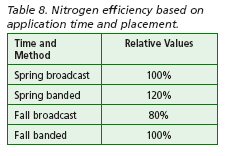 |
Banded values are based on any subsurface band application. This includes with-the-seed band, as long as the rate applied does not exceed the safe limit at which damage to germination and seedling emergence may occur. For maximum benefit, bands should not be disturbed prior to or during the seeding operation.
Nitrogen losses due to leaching, gaseous loss, immobilization and weed growth are probably higher for fall-applied than for spring-applied nitrogen. These losses may be greater if the nitrogen is applied too early in the fall (prior to mid-September) or when soil temperatures at the 4" depth are greater than 5°C. Loss of N accounts for much of the difference in efficiency between fall and spring applications. Under dry soil conditions, the efficiency of nitrogen banded in late fall can approach that of spring banded because potential losses due to leaching or denitrification are low. Efficiency of fall-applied N can be substantially lower than those indicated in Table 8 under excessive moisture conditions in spring or fall and/or an early fall application before soils have cooled to 5°C.
Poorly drained soils or depressions, including "microdepressions" in the generally level landscape of the Red River Valley have high potential for loss of nitrate-N. These losses have been shown to be minimized in management studies through proper placement and timing of nitrogen 18 . (Figure 2)
In a practical sense, time and method of application should be based not only on the needs of the crop and potential losses from the soil, but also on coordination of the soil fertility program with an efficient overall farm management system. Select a time and method of N application that permits preparation of a good seed bed, conserves soil moisture, aids in prevention of soil erosion, allows for timeliness of operations and maximizes net returns.
Figure 2 Effect of date of fall N application on wheat grain yields from fallbanded urea relative to spring-banded urea at depressional and upper slope positions at three sites near Winnipeg and one site near Brandon (2001-2002).
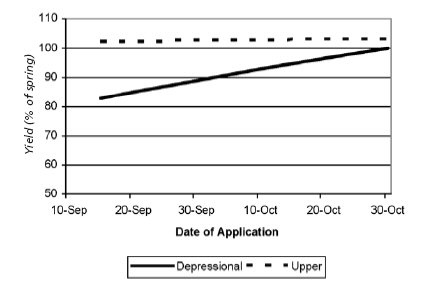
Fertilization of forage grasses
Nitrogen rates
Forage grasses respond well to N fertilization. Unfortunately hayfields in Manitoba often receive little to no fertilization, which can limit the protein content and yield potential of the crop. In Manitoba, the optimum amount of N recommended for established stands of grass hay is in the range of 90 to 110 lb/ac. It is likely that these rates of N application are too low with good rainfall and too high when moisture is limiting.
Manitoba studies show that moisture availability in the soil and the selling price of baled hay are key factors in determining the most profitable rates of N application. In these studies, the level of N supply that gives maximum profit is called "the economic optimum N supply" and can vary with different grass species and moisture conditions. By subtracting soil test values for nitrate-N from the values for economic optimum N supply, producers can determine the most profitable rates of N-fertilizer application.
Forage yield and nitrogen removal may be very high under the combination of high moisture conditions and nitrogen supply. Growers choosing to use manure to supply nitrogen to forage grasses must be aware that phosphorus will be supplied at levels above that required and soil P levels will increase. Current manure regulations may limit the amount that can be applied to forage.
Recommendations based on the soil test are listed in Appendix Table 14, 15 and 16.
Figure 3 Economically optimum nitrogen requirement for smooth bromegrass/ intermediate wheatgrass under various moisture conditions and hay selling prices.
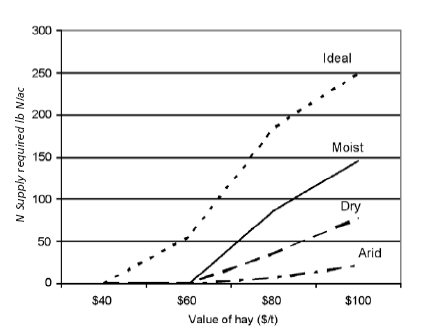
Assumes fertilizer at $0.41/lb N and hay cutting and handling cost of $25/t. Optimum N supply is soil nitrate-N to 24" plus fertilizer N.
In Figure 3 19 , Manitoba soils are categorized into four groups according to the amount of available moisture, which modifies the yield response to N fertilizer.
Ideal soils occur under irrigation or when yield is not limited by lack of rainfall.
Moist soils are typical of the clay soils of the Red River Valley and the Grey Wooded soils which have high water holding capacity or are in the cooler soil areas but are subject to periodic dry conditions.
Dry soils include the sandy soils in southwestern Manitoba and are intermediate in water-holding capacity and are subject to dry weather conditions.
Arid soils are well drained, coarse-textured soils that have a poor ability to hold water and are subject to dry conditions on a regular basis. Most soils in the province are in either the moist or dry category.
The timothy hay export market is a new opportunity for Manitoba hay producers. Recommended N rates may be lower than required for optimum hay or seed yield due to quality concerns. The primary quality factor for export hay is greenness. High N rates tend to promote lodging and leaf disease, which reduce the green colour. Studies 20 have shown that 100 lb of total N/ac (fertilizer and soil N) will optimize yield with acceptable quality ( Appendix Table 14). Growers have also observed improvements in quality when N is split (half in early spring and the remainder 4-6 weeks later in June) or injected directly into the stand in June with disk or spoke injection.
High nitrogen rates are usually required for forage grass seed and vary by species (Table 9) 21, 22, 23, 24 .
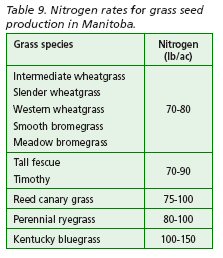
Sources of Nitrogen
Ammonium nitrate is generally 10-15% more efficient than urea in increasing yield of the first cut of early season grasses. Manitoba studies have found that under conditions of minimal volatilization loss, urea forms are equal or superior to ammonium nitrate for fertilizing late season grasses in multiple harvest systems and grass pasture. In these instances, hay or pasture grasses fertilized with urea have higher crude protein levels than those fertilized with ammonium nitrate 25 .
Supplies of ammonium nitrate are limited, so growers will need to consider alternative practices. Options include broadcast urea, ammonium sulphate or UAN solution applied through injection or surface dribble banded. Under high risk conditions for urea volatilization, consider treatment of urea and UAN with Agrotain.
Volatilization losses of surface applied N may be very high if rainfall is not received soon after application. Volatilization losses are greatest when urea is applied to a moist thatch cover, followed by warm, windy weather.
Broadcast N solutions are not satisfactory for established forages. To increase efficiency, N solutions should be surface or dribble banded or injected into the soil with equipment such as the spoke wheel applicator.
Time of application
| Grass for hay or pasture: The relative efficiency of broadcasting granular N fertilizer on established grass is as follows (Table 10): The efficiency of split-rate N applications (applying one-half the required N in the spring and the other half immediately following the first cut) is similar to a single spring application 26 . The split-application technique has the added advantage of equalizing the production of forage with a relatively high protein content during the growing season. It is also useful for pasture production where rotational grazing is practiced. Split application of less than 45 lb N/ac is not recommended. |
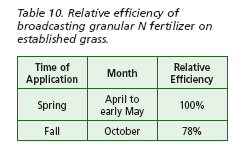 |
Grass for seed production: Timing of N fertilizer application for grass seed production is very important and varies with species (Table 11). Nitrogen promotes the growth of tillers and by stimulating the growth of larger seed heads in those tillers that will form seed heads. Tillers must have grown enough to be induced to form seed heads by the correct daylength and temperature for each species. Since the period of the year when this physiological change occurs differs among grass species, the timing of nitrogen need changes.
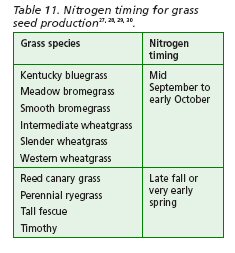
For further information, contact your MAFRD GO Representative.
